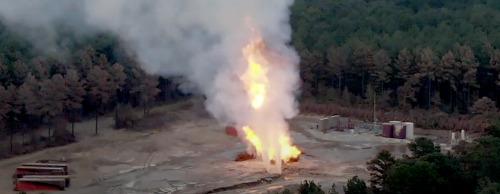Remote Sensing of Environment ( IF 13.5 ) Pub Date : 2021-11-16 , DOI: 10.1016/j.rse.2021.112755 Joannes D. Maasakkers 1 , Mark Omara 2 , Ritesh Gautam 2 , Alba Lorente 1 , Sudhanshu Pandey 1 , Paul Tol 1 , Tobias Borsdorff 1 , Sander Houweling 1, 3 , Ilse Aben 1

|
We quantify and characterize methane emissions from a natural gas well blowout in Louisiana, USA in 2019 using TROPOMI (TROPOspheric Monitoring Instrument) methane observations and VIIRS (Visible Infrared Imaging Radiometer Suite) gas flare detections. We use TROPOMI data in a Bayesian inversion to optimize daily methane emissions while VIIRS-based radiant heat data are used to estimate the amount of gas flared. This hybrid approach allows for the characterization of methane emissions during both the flaring and venting phases of the blowout, where more than half of the blowout duration was associated with flaring. We estimate overall emissions of this 38-day event at 49 (21–63) Gg, which is lower than reported by the gas company but exceeds all known US point sources emitting at the time in terms of emission rate. We estimate that over 80% of total emissions come from the venting phase, leaving the flaring phase responsible for only a small fraction of total emissions. We show that routine satellite operations from global-scale observing instruments such as TROPOMI and VIIRS when combined can provide a detailed assessment of quantitative greenhouse gas emissions from large point sources including stochastic events and thus these data could be used for regulatory enforcement.
中文翻译:

使用天基观测重建和量化 38 天天然气井井喷的整个持续时间的甲烷排放
我们使用 TROPOMI(对流层监测仪器)甲烷观测和 VIIRS(可见红外成像辐射计套件)气体耀斑检测来量化和表征 2019 年美国路易斯安那州天然气井井喷的甲烷排放。我们在贝叶斯反演中使用 TROPOMI 数据来优化每日甲烷排放量,而基于 VIIRS 的辐射热数据用于估计燃烧的气体量。这种混合方法允许在井喷的燃烧和放空阶段表征甲烷排放,其中超过一半的井喷持续时间与燃烧有关。我们估计这次 38 天事件的总排放量为 49 (21-63) Gg,低于天然气公司报告的值,但在排放率方面超过了当时所有已知的美国点源排放量。我们估计超过 80% 的总排放量来自排放阶段,而燃烧阶段仅占总排放量的一小部分。我们表明,全球尺度观测仪器(如 TROPOMI 和 VIIRS)的常规卫星操作在结合时可以提供对包括随机事件在内的大型点源的定量温室气体排放的详细评估,因此这些数据可用于监管执法。


























 京公网安备 11010802027423号
京公网安备 11010802027423号